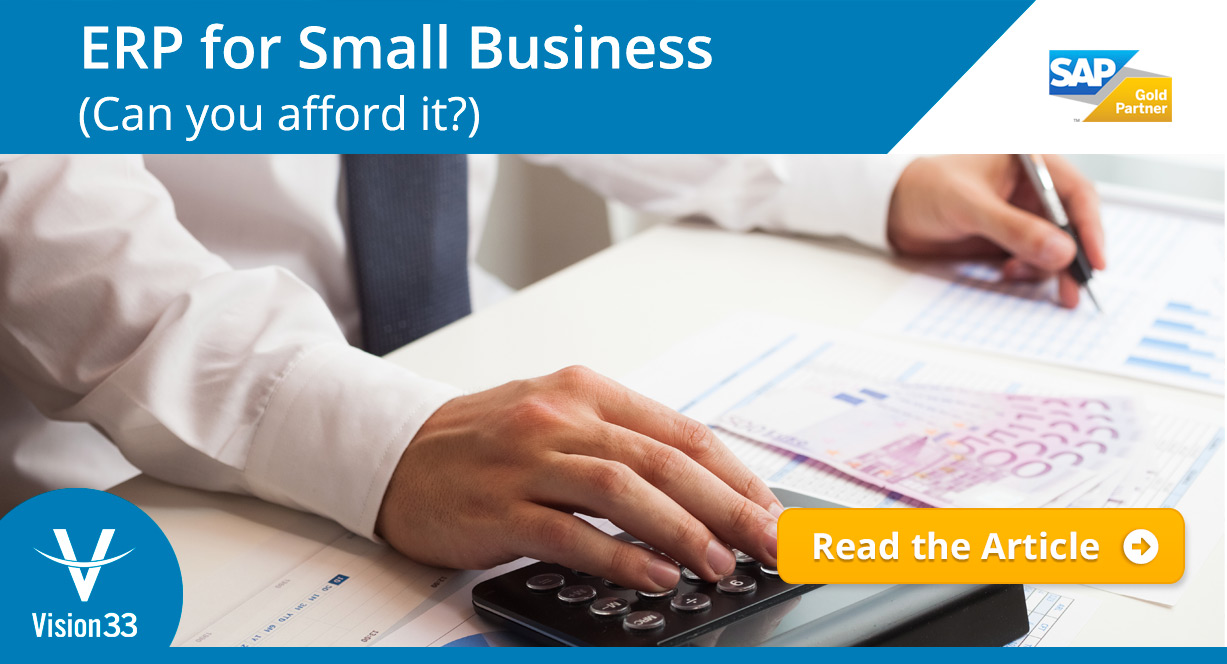Boosting Business Growth: 5 Tips for Getting the Most Out of an ERP Solution
SAP Business OneChoosing the right ERP solution for your small business— & maximizing its value—requires careful...

September 11, 2019
Blog > ERP for Small Business (Can You Afford It?)
Small companies often face a dilemma in deciding how to invest for the greatest return. In pure startup mode, businesses must invest in an operational foundation that will directly build the business. "Management by walking around: is common. Reporting is ad hoc, supported by manual processes and spreadsheets. Decision-making is driven more by gut feel than data and hard facts. These methods may be effective in early phases of the business, but once past that crucial startup phase, neglecting to invest in appropriate enterprise business systems can significantly hinder continued growth and profitability. Many businesses stumble along with some combination of spreadsheets and disparate applications thinking an integrated Enterprise Resource Planning (ERP) solution is beyond their reach. In reality, though, rather than assuming they can't afford it, small and growing businesses should instead be asking, " Can we afford not to invest in ERP?"
You're not in control: Processes are manual; data is scattered in file cabinets, offline spreadsheets, and across desktops. That data is transferred between desks four or five or even six or eight times, adding little value and introducing the risk of Errors.
You've no idea how or where to expand: Your business is growing. You want to continue to add new geographies and new market segments. But you have no visibility as to where you made your best profit. Was it in healthcare in the northeast? Was it in commercial business on the west coast? Was it in government contracts?
You can't meet customer demand: Your inventory levels are rising, yet you still can't seem to meet customer requested ship dates. How do you better forecast demand, lean out your inventory, and produce product just-in-time?
Cash is tight: Whether you need to finance your supply chain costs or invest in growth, credit is still tight. You are handicapped in maintaining a close eye on cash and liquidity.
You have no IT staff: The closest you have to an Information Technology (IT) staff is that bright kid you hired to manage your internal network, your laptops, and phones. Technology is leaving you behind, but you're growing and would rather invest in revenue-generating activities, not overhead.

If any of the scenarios above resonated, the downside of not having ERP is all too obvious. Think about the amount of time you and your subordinates spend each day searching for data that could and should be readily available and literally at your fingertips. Without full and immediate access, you run the risk of delaying decisions or, perhaps worse, making decisions based on incomplete or incorrect data. Spreadsheets, the universal management tool, provide a familiar and convenient means of analyzing and manipulating data but offer no means of creating a detailed and accurate audit trail. Relying exclusively on paper or email trails to provide an auditable system of record is both time consuming and dangerous.
If you are a hard goods product-based business, determining real margin analysis is difficult, if not impossible. Inventory accuracy and accurate lead time projections are critical but difficult to achieve. If your business is service or project-based, not being able to provide an accurate estimate of costs quickly may prevent you from presenting timely estimates and quotes that insure you can compete on price, yet only accept profitable business.
Desktop-based or legacy applications may seem viable alternative, particularly if they are ingrained into your current business processes. Most likely, they were implemented back when the performance of your business was easily measured based on price, quality, and on-time delivery. But today a forth metric of performance has become the norm, and that fourth metric is interoperability within your business network. As a small company, you are likely doing business with companies much larger than you, and more demanding.
It is highly likely, even as a small company you are faced with complexity introduced through international trade and must navigate a tangled web of international requirements and regulations. Legacy applications do not provide the same level of international features or integration and interoperability as an integrated ERP suite.
And as you begin to expand into international markets, you are faced with having to support multiple financial reporting standards, particularly if you want banks to lend you money. Although credit is not as impossible to acquire as it was during the credit crisis, it is still tight, making the need to manage cash flow all that much more critical. Collecting as early as possible, paying at the most optimal time, and investing any leftover cash in something that yields the highest possible return with an acceptable level of risk; forecasting cash available at any given time, however, remains difficult.
So for many small companies today, table stakes have increased. But beyond those table stakes, the global economy is making it tougher and tougher to maintain a competitive advantage. Outperforming a growing field of competitors requires a performance-based culture, supported by strong processes, audit trails, and reliable data that is immediately accessible. Neither spreadsheets and manual processes nor non-integrated legacy applications can compete with the added value an integrated ERP solution can bring to the table.

ERP often gets a bad rap. Many industry observers focus on failed and expensive implementations that never seem to end, thereby tending to scare small companies away. The goal of ERP is often cost savings, but you initially need to spend money (and time and effort) to save money. Focusing exclusively on the cost of ERP, even the Total Cost of Ownership (TCO), will not overcome the initial reluctance to invest. Instead, any company (large or small) investing in ERP needs to justify the expenditure by estimating the return on that investment, either in terms of dollars or time to recoup the initial investment or both. These savings can be as diverse as the companies themselves.
Often the timing of the investment can be critical. Undoubtedly, many small companies were reluctant to take on this type of project and fund this level of investment during the economic downturn. With revenues down or stagnated, they could potentially wait until better times were upon them. But now, as companies begin once again to develop growth strategies, further delay involves further risk. Waiting until you can't operate effectively without it can spell disaster.
There has never been a better time to consider upgrading your technology. Whether your goal is to support anticipated growth or to work more efficiently and productively, several market factors converge to signal now is the time.
First of all, prices have come down, making ERP more affordable than it has ever been. Not only has the price of entry come down, but the process of evaluating alternatives no longer needs to be as disruptive as it has been in years past. Online materials, testimonials, and demos and even trial software make it much easier to perform some preliminary qualification through your research before you ever make contact with the software solution provider.
But don't make the mistake of thinking you already know all there is to know about an ERP product based on website visitation and old or presumed knowledge. In the past several years, many of the top ERP solutions have made enormous strides in terms of the underlying technology and that technological infrastructure brings better ease of use, faster innovation, and more features and functions. The "horizontal" core functionality of traditional ERP solutions has become more of a commodity. "Horizontal" implies features and functions any business requires. But you also may need industry-specific "vertical" functionality which means all ERP solutions are not "one size fits all" applications.
When evaluating options look carefully to see how that added functionality is delivered. Unless you are looking at a very narrow, niche solution, it is highly likely to serve multiple industries. Look not only at features but also determine how your specific needs are met and whether this introduces an added level of complexity to the solution. This need not be the case. Many solutions today can be pre-configured with implementation templates and best practices. Look for role-based interfaces and configurable dashboards and navigation trees that can be tailored to individuals.
Even horizontal solutions today come with more tailor-ability and customization. Solutions that may have required heavy customization to meet your needs just a few years ago have undergone major transformations that will help you transform your own business. IN the past, you may have had to choose between adapting your business processes to match the functionality of the software, and adapting the software to conform to your current practices. Today user interfaces can be tailored to roles, and individual preferences and business rules can be established to customize workflows and processes without ever having to muck around in the underlying software code.
This is an important characteristic, even if you do not require any specific customization today. In a world where nothing is constant but change, plan on your business needs changing over time.

Another reason the time is right is the improvement in ease of use, particularly in those ERP solutions designed with the small company in mind. In some cases, the complexity inherent in applications designed for large multi-national companies has been removed. In other cases, it has been masked, effectively shielding the small company from dealing with many of the decisions and features that are the exclusive domain of large enterprise. And in other cases, complexity was never built-in.
The added ease of use can often be attributed to more intuitive interfaces. Many have the same familiar Microsoft Windows look and feel that we are all accustomed to today and are far more easily navigated than the hierarchical menu structure of years gone by. As a result, less training will be required in terms of use and navigation. But don't neglect the evaluation of business processes. And don't neglect process standardization and process improvement. ERP can be the vehicle by which you both standardize and improve. This is where training is still required, regardless of how easy software is to navigate.

Worried about having to build an IT staff? Maybe you don't need to. Today there are multiple options for deployment, as well as options for the ongoing care and feeding of an ERP solution. With choices comes the potential for confusion. It is important to understand these various options.
Terms such as software as a service (SaaS), on-demand, hosted, and cloud computing are often used interchangeably, and yet each has its implications, and some of these approaches can be co-mingled.
Software is typically not bought and sold; instead, it is licensed for use. It may be licensed to be used by a company, on a particular computer or by other criteria such as number of users. When installed at the company's site, it is generally referred to as "on-premise." In this case, an internal IT department might be responsible for supporting and maintaining the solution. However, even with on-premise environments, basic functions such as backup, security, operating system, and even business application upgrades can be outsourced.
In a hosted environment, applications are licensed but are hosted by a third-party. This may be in a separate instance on a separate piece of hardware (dedicated to your company), or in a separate virtual instance (also dedicated to your company), or in a separate virtual instance (also dedicated to your company) where the application is housed on hardware shared by multiple companies. In this case, little or no IT support is required at your site.
In a SaaS or on-demand model, the software itself is neither licensed nor owned by the end-user company. The software is delivered as a service and is paid for through a subscription for the service provided. Generally speaking few or no technical resources are required at your site. Cloud terminology is often intermingled with SaaS, but reference to the cloud refers to the operating environment and not how the software is bought or paid for.
To the non-technical ERP users, the most important aspect is that they can connect to the application and its data from any computer with a browser. If this is possible, often the end-user does not know, care or need to know which of these deployment models are being used to deliver the application.
A web-enabled user interface is now counted amongst the "basics" of ERP. It is the most versatile, eliminates the need to install and support software on laptops and other personal computers and allows a small company choice in how the software is deployed and paid for.

In cost-justifying the investment in ERP, it is important to recognize all the potential business benefits. Some of these benefits can be directly measured in cost and time savings (and often time is money). Some may be directly attributed to the implementation of ERP, and some may be indirectly linked. While some of the business benefits, such as increased revenue and increased value delivered to customers, are more indirectly related, inventory costs and production throughput can be directly tied back to business processes that are streamlined and improved by ERP. Reductions in administration and operating costs can also be the direct result of improved efficiencies and productivity, but are not as universally and specifically measured and therefore easily missed.
Cost savings are often the number one goal of an ERP implementation, particularly for manufacturers, partly because the cost and visibility of inventory reductions can be so visible. But any company can reduce indirect and administrative cost for tasks as common as processing customer invoices, matching vendor invoices and making payments on a day-to-day basis, as well as reconciliation, reporting and compliance, and month-end close. There is a cost associated with each of those manual tasks, whether or not it is adequately measured.
Just as importantly, ERP allows a measure of efficiency and control over your business that is not possible to achieve otherwise. Without ERP, often business is managed through spreadsheets, manual processes and paper, possibly augmented with disparate business applications such as stand-alone accounting software, often based on older closed architectures that limit interoperability. The number of times pieces a paper report passes from desk to desk and hand to hand is a measure of inefficiency that is hard to measure but impossible to ignore. Elimination of paper and automation of those processes are exactly what ERP is intended to do.
The net result for Advanced Ventilation, Ltd was not only improved efficiency and productivity but also a measure of visibility that is equally difficult to achieve from paper, spreadsheets, and manual processes. By having all involved operating from a single source of data that is available in real-time, you reduce the risk or errors and omissions.
But internal efficiencies are just the beginning in terms of business benefits that await companies embarking on ERP implementation today. Remember that fourth metric that is increasingly important today - interoperability?
If you are a small business operating without a technology-enabled modern ERP solution, ask yourself the following questions:
If you answered, "no" to any of the questions above, then instead of asking if you can afford ERP, the better question to ask is, "Can you afford to operate without it?" The cost of fully integrated ERP solutions has come down, while at the same time, both ease of use, as well as feature functionality, have improved significantly. A well-executed ERP implementation can enable change and provide on-going savings that can help you sustain and grow your business. Not only will you be operating at a competitive disadvantage, but you can severely handicap growth and profitability.
For more information about ERP readiness, download our article: Five Signs Your Business is Big Enough for ERP where we outline the telltale signs that your business is ready for the next stage of business growth.
Can Your Small Business Afford ERP: Can you afford to operate without it? by Mint Jutras.
Subscribe to our newsletter to receive our latest blog posts, case studies and ERP news delivered straight to your inbox.
Choosing the right ERP solution for your small business— & maximizing its value—requires careful...
Cloud ERP for manufacturing delivers enterprise-level sophistication and efficiency to small and...
Here are 5 reasons SAP Business One is the preferred cloud ERP solution for growing businesses—and...
Recieve our latest blog posts, case studies, and ERP news
delivered straight to your inbox.